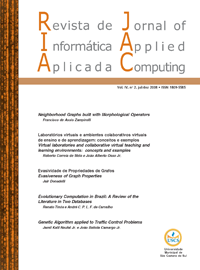Genetic Algorithm applied to Traffic Control Problems
DOI:
https://doi.org/10.13037/ria.vol4n2.313Keywords:
Genetic Algorithms, Artificial Intelligence, High Complexity Problems, Unbalance Between Capacity and Demand, Air Transportation SystemAbstract
There are a great number of high complexity of real systems where the application of advanced computational techniques is necessary in order to obtain good results within the available period of time. The complexity of such systems refers not only to the difficulty to identify all its constituent parts but also due to excessive computational efforts needed to reach a good response for them. This work presents a proposal for implementing the Artificial Intelligence technique called Genetic Algorithm, aiming to resolve a high complexity of real system, which is associated with the unbalance between the capacity and demand in the air transportation system.Downloads
References
BANZHAF, W.; REEVES, C. Foundations of genetic algorithms 5. Morgan Kaufmann Publishers, 1999.
BODENHOFER, U. Genetic algorithms: Theory and applications. Linz-Hagenberg: Lecture Notes, Third Edition, Winter 2004, Fuzzy Logic Laboratorium Linz-Hagenberg, 2004.
CARRASCO R.; CIPRIANO A.; CARELLI R., Nonlinear state estimation in mobile and robots using a fuzzy observer, Departamento de Ingeniería Eléctrica Pontificia Universidad Católica de Chile, Chile, Instituto de Automática Universidad Nacional de San Juan, Argentina, 2005.
CRAIGHURST S.; MARTIN, W. Enhancing genetic algorithm Performance Through Crossover Prohibitions Based on Ancestry. In: CONFERENCE ON GENETIC Algorithms, 6. Proceedings. Morgan Kaufmann, San Mateo, 1995.
DELAHAYE D., OUSSEDIK S., STEPHANE P, Airspace congestion smoothing by multi-objective genetic algorithm, Symposium on Applied Computing archive, Proceedings of the 2005 ACM symposium on Applied computing table of contents, Santa Fe, New Mexico, 2005.
IDG NEWS SERVICE STORY. Compaq builds supercomputers for genomics research. Available on www.idg.net/idgns/2001/01/19/CompaqBuildsSupercomputerForGenomicsRese.shtml, 2001. Acess in 20/07/2004.
FREGNI, E. Architecture in the hybrid solution of the problem of escalation of manufacturing 213 pages. Thesis (Doctorate), Department of Computing and Digital System Polytechnic College, University of São Paulo, 1997.
GAMVROS I.; GOLDEN B., Tutorial: Heuristic Search for Network Design, University of Maryland, IFORMS Denver October 24, 2004
GORDON, V.S.; WHTLEY, D. Serial and parallel genetic algorithms as function optimizers. Fort Collins: Colorado, Colorado State University, Department of Computer Science, 1996.
HOLLAND, J. H. "Outline for a logical theory of adaptive systems". Massachusetts: Association Computer Machine, volume 3, pages 297-314, November 1961.
JUNG, S. H. Queen-bee evolution for genetic algorithms. Electronics Letters, 20th March 2003, vol. 39, No.6, 2003.
KNOEZER, D. Perspectives for the future, looking towards the challenges of the 21st century. DG Research - Aeronautics, Dayton, European Commission Research, July 2003.
QIN L. D.; Q. JIANF Y.; ZOU Z. Y.; CAO Y. J., A queen-bee evolution based on genetic algorithm for economic power dispatch, Zhejiang University, Hangzhou 310027, China, 2005.
SCHWEFEL, H. P.; HAMMEL U.; BACK T. Evolutionary computation: comments on the history and current state. IEEE Transactions on Evolutionary Computation, Vol. 1, N. 1, April 1997.
TERMINAL AREA CONGESTION, Term-2: Terminal Airspace Redesign, National Airspace System, Operational Evolution Plan, version7.1, http://www.faa.gov/programs/oep/v7/smart%20sheets/term2%20terminal%20airspace%20redesign.htm, September 26, 2005
SCHOFIELD, J. Airbus global market forecast. Washington DC: Aviation Forecast Conference, Airbus Industries of North America, March 7-8, 2000
TOMASSINI, M., Evolutionary algorithms. Lausanne: Logic Systems Laboratory, Swiss federal Institute of Technology, Switzerland, 1996.
Downloads
Published
Issue
Section
License
Copyright (c) 2010 Jamil Kalil Naufal Jr., João Batista Camargo Jr.

This work is licensed under a Creative Commons Attribution-NonCommercial-ShareAlike 4.0 International License.
Os autores que publicam trabalhos na RIA estão de acordo com os seguintes termos:
- Autores mantêm seus direitos autorais e concedem à RIA o direito à primeira publicação. Admite-se o compartilhamento do referido trabalho, desde que seja reconhecida sua autoria e publicação inicial nesta revista.
- Autores podem fechar contratos adicionais separadamente, para distribuição não exclusiva da versão do trabalho publicado na RIA, com reconhecimento de sua autoria e publicação inicial nesta revista.
- Autores podem publicar e distribuir seu trabalho online, antes ou durante o processo editorial.


